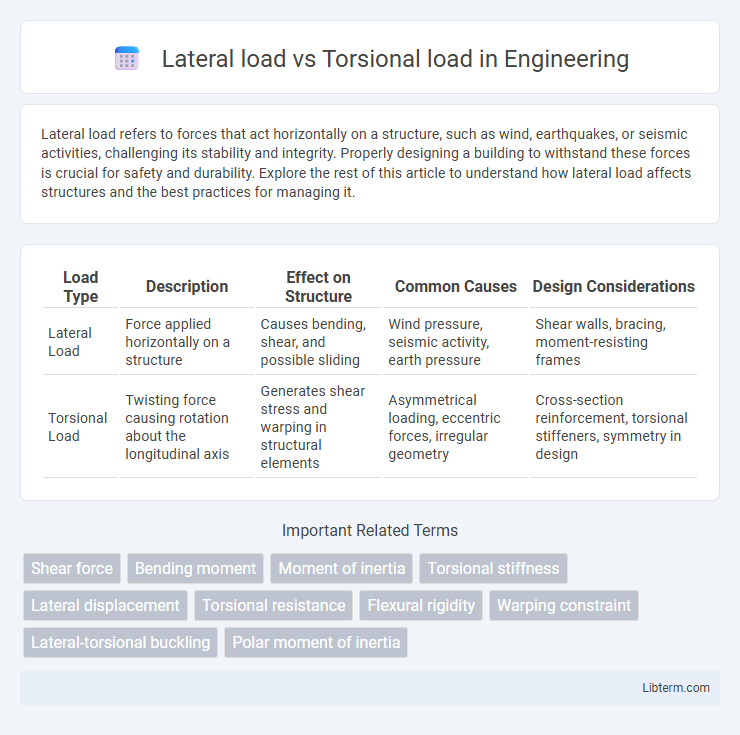Lateral load refers to forces that act horizontally on a structure, such as wind, earthquakes, or seismic activities, challenging its stability and integrity. Properly designing a building to withstand these forces is crucial for safety and durability. Explore the rest of this article to understand how lateral load affects structures and the best practices for managing it.
Table of Comparison
| Load Type | Description | Effect on Structure | Common Causes | Design Considerations |
|---|---|---|---|---|
| Lateral Load | Force applied horizontally on a structure | Causes bending, shear, and possible sliding | Wind pressure, seismic activity, earth pressure | Shear walls, bracing, moment-resisting frames |
| Torsional Load | Twisting force causing rotation about the longitudinal axis | Generates shear stress and warping in structural elements | Asymmetrical loading, eccentric forces, irregular geometry | Cross-section reinforcement, torsional stiffeners, symmetry in design |
Introduction to Lateral and Torsional Loads
Lateral loads are forces applied horizontally to a structure, often caused by wind, seismic activity, or moving vehicles, requiring analysis for stability and structural integrity. Torsional loads involve twisting forces that induce rotational deformation around a structure's longitudinal axis, critical in the design of beams, shafts, and foundations. Understanding the distinction between lateral and torsional loads is essential for engineers to ensure safety, durability, and performance across various construction and mechanical applications.
Fundamental Differences Between Lateral and Torsional Loads
Lateral loads act perpendicular to the longitudinal axis of a structure, causing sideways displacement and shear forces, while torsional loads generate twisting effects by applying moments about the structure's longitudinal axis. Lateral loads primarily induce bending stresses and deflections, whereas torsional loads create shear stresses and warping. Understanding these fundamental differences is essential for designing structural elements to resist combined loading conditions effectively.
Sources and Examples of Lateral Loads
Lateral loads primarily arise from wind pressure, seismic activity, and soil lateral forces impacting structures horizontally. Common examples include wind forces acting on building facades, earthquake-induced ground shaking causing side-to-side motion, and earth pressure against retaining walls. These lateral loads must be carefully analyzed to ensure structural stability and integrity under such dynamic conditions.
Origins and Characteristics of Torsional Loads
Torsional loads originate from twisting forces that cause rotational deformation in structural elements, often resulting from asymmetrical loading or eccentric force application. These loads generate shear stresses distributed across the section, leading to potential warping and torsional bending. Unlike lateral loads that act perpendicular to the member's axis causing bending, torsional loads induce rotational motion and require specialized consideration in design to ensure structural stability.
Structural Responses to Lateral Loads
Structural responses to lateral loads primarily include bending, shear, and lateral displacement in beams, columns, and frames, which help resist forces such as wind or seismic activity. Lateral loads generate bending moments and shear forces that induce deformation and potential structural drift, affecting the stability and serviceability of buildings. Unlike torsional loads that cause twisting and warping, lateral loads predominantly produce lateral sway and stress distribution along the structure's height.
Structural Behavior Under Torsional Loads
Under torsional loads, structures experience twisting that generates shear stresses along their cross-sections, often leading to warping and increased deformation compared to purely lateral loads. The distribution of torsional stresses depends on the geometry and stiffness of the structural members, with open sections being more susceptible to significant torsional effects. Accurate analysis of torsional behavior is critical in structural engineering to ensure stability, prevent fatigue failure, and optimize design in elements such as beams, shafts, and bridge components.
Design Considerations for Lateral Load Resistance
Lateral load resistance design prioritizes structural stability against forces such as wind and seismic activity, ensuring the building framework remains rigid and prevents excessive sway. Key considerations include incorporating shear walls, bracing systems, and moment-resisting frames to effectively transfer lateral loads to the foundation. Material selection and connection detailing play crucial roles in enhancing ductility and energy dissipation, crucial for withstanding dynamic lateral forces.
Torsional Load Mitigation Strategies
Torsional load mitigation strategies primarily involve increasing the structural stiffness and symmetry to resist twisting forces effectively. Techniques such as adding shear walls, using braced frames, and installing torsional dampers help distribute torsional stresses and reduce deformation. Employing these methods enhances the building's resilience against torsional loads compared to lateral load resistance, which mainly addresses horizontal forces like wind or seismic activity.
Comparative Analysis: Lateral Load vs Torsional Load
Lateral loads act perpendicular to a structure's longitudinal axis, causing bending and shear stresses primarily in beams and walls, while torsional loads induce twisting about the structure's longitudinal axis, generating shear stresses around the cross-section. Structures subjected to lateral loads require robust bracing and shear walls to resist displacement and maintain stability, whereas torsional load resistance demands enhanced rigidity and symmetric design to minimize rotational deformation. Understanding the distinct distribution and impact of lateral versus torsional loads is critical for optimizing structural design, material selection, and safety performance under varying load conditions.
Conclusion: Importance in Structural Engineering
Lateral load and torsional load each play critical roles in structural engineering, influencing a building's stability and resilience against wind, seismic activity, and other forces. Proper analysis and design to resist these loads ensure the structural integrity and safety of constructions, preventing failures such as sway, twisting, or collapse. Emphasizing the combined effects of lateral and torsional loads leads to more efficient and durable building designs aligned with modern engineering standards.
Lateral load Infographic

 libterm.com
libterm.com